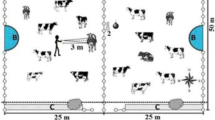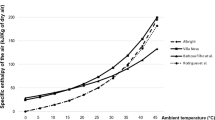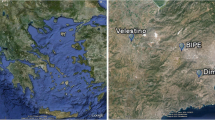Abstract
The aim of this study was to build a prediction model both sensible and latent heat transfer by respiratory tract for Morada Nova sheep under field conditions in a semiarid tropical environment, using easily measured physiological and environmental parameters. Twelve dry Morada Nova ewes with an average of 3 ± 1.2 years old and average body weight of 32.76 ± 3.72 kg were used in a Latin square design 12 × 12 (12 days of records and 12 schedules). Tidal volume, respiratory rate, expired air temperature, and partial vapor pressure of the expired air were obtained from the respiratory facial mask and using a physiological measurement system. Ewes were evaluated from 0700 to 1900 h in each day under shade. A simple nonlinear model to estimate tidal volume as a function of respiratory rate was developed. Equation to estimate the expired air temperature was built, and the ambient air temperature was the best predictor together with relative humidity and ambient vapor pressure. In naturalized Morada Nova sheep, respiratory convection seems to be a mechanism of heat transfer of minor importance even under mild air temperature. Evaporation from the respiratory system increased together with ambient air temperature. At ambient air temperature, up to 35 °C respiratory evaporation accounted 90 % of the total heat lost by respiratory system, on average. Models presented here allow to estimate the heat flow from the respiratory tract for Morada Nova sheep bred in tropical region, using easily measured physiological and environmental traits as respiratory rate, ambient air temperature, and relative humidity.






Similar content being viewed by others
References
Alexander G, Williams D (1962) Temperature regulation in the newborn lamb. VI. Heat exchanges in lambs in a hot environment 13:122–143
Bennett JW (1973) Regional body surface area of sheep. J Agric Sci 81:429–432
Berman A (2005) Estimates of heat stress relief needs for Holstein dairy cows. J Anim Sci 83:1377–1384
Brockway JM, McDonald JD, Pullar JD (1965) Evaporative heat loss mechanisms in sheep. J Physiol Lond 179:554–568
Da Silva RG (2008) Biofísica ambiental: Os animais e seu ambiente. São Paulo, Brazil
Da Silva RG, Maia ASC (2011) Evaporative cooling and cutaneous surface temperature of Holstein cows in tropical conditions. Braz. J Anim Sci 40:1143–1147
Da Silva RG, Maia AS (2013) Principles of animal biometeorology. New York
Da Silva RG, Minomo FR (1995) Cicardian and seasonal variation of the body temperature of sheep in a tropical environment. Int J Biometeorol 39:69–73
Da Silva RG, Starling JMC (2003) Cutaneous and respiratory evaporation in sheep under high ambient temperatures. Braz. J Anim Sci 32:1956–1961
Da Silva RG, La Scala N Jr, Lima Filho AE, Catharin MC (2002) Respiratory heat loss in the sheep: a comprehensive model. Int J Biometeorol 46:136–140
Da Silva RG, Guilhermino MM, Morais DAEF (2010) Thermal radiation absorbed by dairy cows in pasture. Int J Biometeorol 54:5–11
Da Silva RG, Maia AS, Costa LLM, Queiroz JPAF (2012) Latent heat loss of dairy cows in an equatorial semi-arid environment. Int J Biometeorol 56:927–932
Egito AA, Mariante AS, Albuquerque MSM (2002) Brazilian program of animal genetic resources conservation. Arch Zootec 51:39–52
Fonsêca VFC, Saraiva EP, Pimenta Filho EC, Furtado DA, Mariz TAM, Silva ALS, Almeida MEV, Pinheiro AC (2014) Influence of the climatic environment and duration of labor on the mother-offspring interaction in Morada Nova Sheep. J Anim Sci 92:4123–4129
Gatenby RM (1986) Exponential relation between sweat rate and skin temperature in hot climates. J Agric Sci 106:175–183
Hofman WF, Riegle GD (1977) Thermo respiratory responses of shorn and unshorn sheep to mild heat stress. Resp Physiol 30:327–338
Hofmeyer HS, Guidry AJ, Waltz FA (1969) Effects of temperature and wool length on surface and respiratory evaporative losses of sheep. J Appl Physiol 26:517–523
Johnson KG (1991) Body temperatures and respiratory rates of free-ranging Merino sheep in and out of shade during summer. Aust J Agric Res 42:1347–1357
Ligeiro EC, Campos Maia AS, daSilva RG, Loureiro CMB (2006) Heat loss by cutaneous evaporation associated with hair coat morphological characteristics of dairy goats bred in tropical environment. Braz J Anim Sci 35:544–549
Maia AS, da Silva RG, Loureiro CMB (2005) Respiratory heat loss of Holstein cows in a tropical environment. Int J Biometeorol 49:332–336
Maia ASC, da Silva RG, Nascimento ST, Nascimento CCN, Pedroza HP, Domingos HGT (2015) Thermoregulatory responses of goats in hot environments. Int J Biometeorol 59:1025–1033
Maia ASC, Nascimento ST, Nascimento CCN, Gebremedhin KG (2016) Thermal equilibrium of goats. J Therm Biol 58:43–49
Mitchell B (1972) Relationship between body weight and tidal volume during general anaesthesia in sheep, cattle, pigs and horses. Vet Anaest Analg 3:56–60
Neiva JNM, Teixeira M, Turco SHN, Oliveira SMP, Moura AAAN (2004) Effect of thermal stress on the physiological and performance parameters of sheep maintained in confinement in the northeast of Brazil. Braz J Anim Sci 33:668–678.
Oliveira SEO, Costa CCM (2013) Respiratory heat loss in Morada Nova sheep in Brazilian semi-arid regions. J Anim Behav Biometeorolol 1:17–20
Schmidt-Nielsen K (1991) Animal physiology: adaptation and environment, 4th edn. Cambridge University Press, Cambridge
Silanikove N (2000) The physiological basis of adaptation in goats to harsh environments. Sma Rum Res 35:181–193
Silva RB (2013) Effect of environment in the physiological variables and methane emission associated to production and heat loss in sheep. Dissertation, Universidade Estadual Paulista
Starling JMC, daSilva RG, Cerón-Munhoz M, Barbosa GSSC, Paranhos da Costa MJR (2002) Analyses of some physiological variables for evaluation of adaptation level on sheep submitted to heat stress. Braz J Anim Sci 31:2070–2077
Stevens DG (1981) A model of respiratory vapor loss in Holstein dairy cattle. Trans ASAE 24:151–158
Acknowledgments
We gratefully acknowledge the support of the Animal Science Department and Animal Biometeorology Laboratory of the Universidade Estadual de São Paulo, Brazil. This study was supported by Research Foundation of São Paulo State (FAPESP; Process number: 2011/17388-6). We thank all members of the Behaviour and Biometeorology Group of the Universidade Federal da Paraíba (BIOET) and the members of the Animal Biometeorology Innovation Group of the Universidade Estadual de São Paulo (INOBIO).
Author information
Authors and Affiliations
Corresponding author
Electronic supplementary material
ESM 1
(DOC 958 kb)
Rights and permissions
About this article
Cite this article
Fonseca, V.C., Saraiva, E.P., Maia, A.S.C. et al. Models to predict both sensible and latent heat transfer in the respiratory tract of Morada Nova sheep under semiarid tropical environment. Int J Biometeorol 61, 777–784 (2017). https://doi.org/10.1007/s00484-016-1255-3
Received:
Revised:
Accepted:
Published:
Issue Date:
DOI: https://doi.org/10.1007/s00484-016-1255-3




